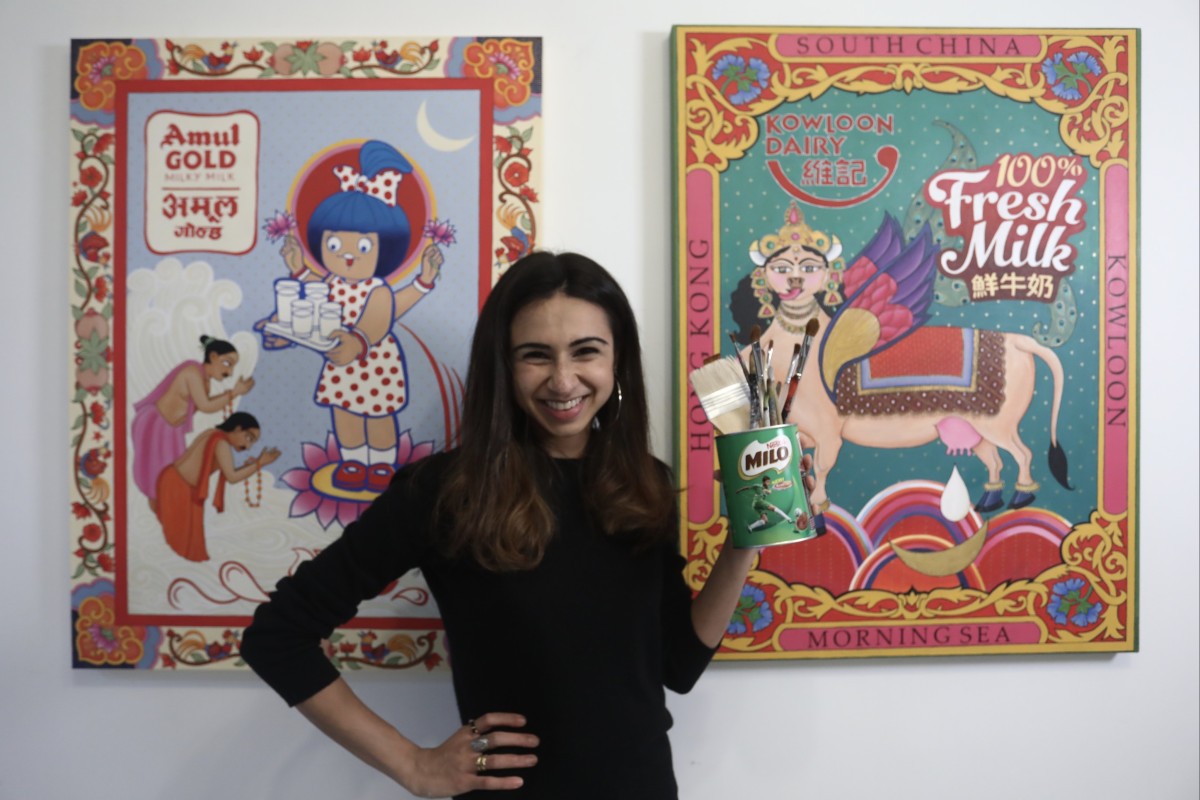
Cereal mascots meet Hindu goddesses: Hong Kong artist Riya Chandiramani on the personal and political in her work
- The Indian Hongkonger shares how mental health treatment helped her unlearn harmful messages she was told about herself and the world – ideas she now challenges with art
- Every week, Talking Points gives you a worksheet to practise your reading comprehension with questions and exercises about the story we’ve written
 Hong Kong artist Riya Chandiramani explains how her art discusses broad social issues such as feminism and capitalism. Photo: Jonathan Wong
Hong Kong artist Riya Chandiramani explains how her art discusses broad social issues such as feminism and capitalism. Photo: Jonathan WongRiya Chandiramani’s artwork contains layers of meaning. You can spot this in her painting Behind Every Man, in which Tony the Tiger, the mascot of Frosted Flakes cereal, sits on a lotus while a Hindu goddess’ arms peek out from behind him. It represents that behind every man is a powerful woman.
This is just one piece in the 27-year-old’s cereal mascots series, which began as a way to cope with the chaos of the Covid-19 pandemic.
“I hold on to my childhood during hard times, and for me, cereal boxes are a connection to that time,” explained the artist, who is an Indian Hongkonger.
Not only does the series explore larger themes of capitalism, feminism and religion, but it is also connected to the artist’s relationship with food and nourishment.
When Chandiramani was 16 and a student at German Swiss International School, she said she suffered from serious depression and anxiety.
“My school did not have great counselling services, and it [mental health] just wasn’t a subject discussed in my family,” she said. “I was lost for the last two years of secondary school.”
The teen threw herself into her studies, making her grades a priority. Her mental health only got worse after she graduated and moved to the US to study at the University of Pennsylvania. She began restricting her food intake, explaining, “I had always looked to numbers to define my self-worth, and this was a new way to do so.”
Chronically-ill artist felt she lost her career – a gift changed her life
“I did not let myself have any fun. I would just study and exercise – I barely even slept. I looked like I was doing well, but behind closed doors, I was not OK,” she said, adding that she did not think of herself as anorexic at the time; for her, her habits were forms of control and punishment.
However, her behaviours fit the British National Health Services’ definition of an eating disorder as a mental health condition in which someone uses the control of food to cope with feelings and other tough situations.
“Everyone knew I had an eating disorder except me,” she said.
Chandiramani eventually left university for residential treatment, saying that though she was “kicking and screaming” at first, it turned out to be exactly what she needed.
Psychologist explains why emotions should be a school subject
“It changed me,” she said. “Through my eating disorder, I saw how wrong the world was behaving – around food, around ... health, around women.”
“I had to re-feed myself to recover – not just food, but new messaging surrounding what it means to be a woman and a self-respecting human.”
She pointed to the ideas she had to unlearn: from media’s depictions of the ideal woman with an unattainable body, to messaging from religious stories that encouraged her to be “a subservient, quiet, shrunken down girl who does not have a voice”.
“Mental health is just like a physical illness: it has a cause. Recovery has been about identifying those causes and working to change the belief systems and conditioning that developed into an illness,” the artist shared.
How this 13-year-old artist translates her emotions onto the canvas
After completing treatment and finishing university, Chandiramani returned to Hong Kong in 2017 and soon started working for The Women’s Foundation.
At the same time, she was holding on to her passion for art, which she had loved since she was a child. She started doing commissions on the side, often working into the early hours of the morning to finish.
In 2018, Chandiramani decided to become a full-time artist, working on commissions for murals, shoes and bags. While she enjoyed it, it was not fulfilling.
Thus, in the early days of the pandemic, she began focusing on art that spoke to her – which is when she began creating her cereal box series.
Her artistic style fuses Indo-Persian art, pop art and propaganda posters to critique messages she sees in society about women and consumerism.
She explained that in the same way we are physically fed with food, capitalism – a system in which private owners control industry for their own profit – also feeds us messages: companies try to make more money by advertising the idea that if we keep buying, we will be happy.
The artist also wanted her work to challenge society’s framing of men and women, noting how most cereal mascots were male, though mothers would usually be the ones nourishing children.
This ties into the idea that “women are the life-givers ... whose power is then suppressed or given to men,” she said.
Photo exhibition shows how Hong Kong ethnic minority youth picture belonging
While her art depicts religious iconography in the form of Hindu goddesses, it is not about religion specifically. Chandiramani’s work is about understanding that goddesses’ powers also lie within us.
“Many of today’s beliefs ... of Indian society stem from ancient scriptures that were never meant to be taken as law,” she explained. “It’s about what these stories that shaped a civilisation symbolise, and how these beliefs are practised.”
“[I am] reimagining cereal boxes to not only include and represent women, but represent the mother goddess, the origin of creation and all nourishment, for the most important meal of the day.”
You can check out Chandiramani’s work at a group art show, “Delirium”, presented by Young Soy Gallery. The show will take place from July 7 to 16 at 49 Hollywood Road in Central.
Click here to download a printable worksheet with questions and exercises about this story. Answers are on the second page of the document.
